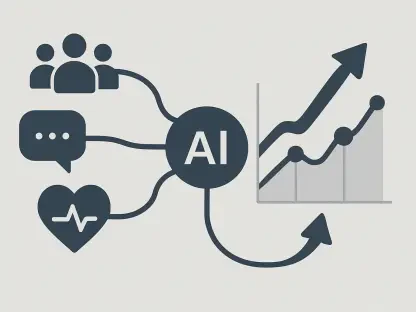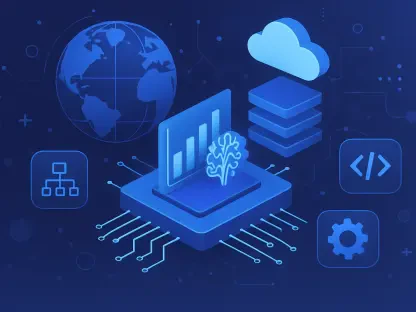In 2024, the field of Artificial Intelligence (AI) remains one of the most transformative and debated technological trends. AI has rapidly transitioned from experimental phases to real-world applications, influencing various sectors such as healthcare, automotive, and finance. This article aims to provide a comprehensive overview of AI’s current market dynamics, adoption rates, sector-specific impacts, and projected future trends. By analyzing key statistics and growth projections, this piece paints a vivid picture of AI’s evolving landscape.
Market Expansion and Projections
Exponential Growth Trajectory
The global AI market, valued at approximately $279 billion in 2024, is on a remarkable growth trajectory. This market value is expected to swell to around $1.81 trillion by 2030, indicating a robust compound annual growth rate (CAGR) of 38.1% between 2022 and 2030. Such exponential growth underscores the increasing reliance on AI technologies across multiple industries. The AI software sector alone boasts an annual revenue of about $100 billion, contributing significantly to this market expansion. As AI applications become more sophisticated and accessible, the demand for AI solutions across various business functions is expected to surge.
Moreover, detailed projections suggest that the AI market in the United States will grow to $300 billion by 2026, a testament to the technology’s ubiquitous presence and substantial investments. China, a major player in the AI race, is anticipated to account for over one-quarter of the global AI market by the decade’s end. This geographic spread not only highlights the widespread adoption of AI but also signifies the competitive landscape involving major economies. As countries and companies vie for AI supremacy, the technology’s global footprint continues to expand, driving further innovations and market opportunities.
Sector-Wise AI Integration
AI’s integration across different sectors is one of the most notable trends driving its market growth. In healthcare, AI technologies are revolutionizing diagnostics, with approximately 38% of medical professionals utilizing AI tools for enhanced diagnostic accuracy. This trend is expected to persist as AI algorithms become even more adept at identifying diseases and recommending treatments. The healthcare sector also benefits from AI’s ability to manage patient data efficiently, forecast medical needs, and streamline administrative tasks, thus improving overall healthcare delivery.
The marketing and sales sectors are experiencing tremendous changes courtesy of AI. About 50% of sales departments report increased lead generation and significant cost reductions due to AI deployment. These AI solutions leverage predictive analytics and machine learning (ML) to identify potential customers, streamline marketing campaigns, and personalize customer interactions. In manufacturing, AI’s impact is equally profound, with automation and predictive maintenance technologies enhancing productivity and reducing operational downtimes. By 2035, the manufacturing sector stands to gain an additional $3.78 trillion, reflecting AI’s transformative potential.
Business Adoption and Competitive Edge
Increasing AI Adoption Rates
Between 2015 and 2019, AI utilization within businesses surged by an impressive 270%. As of 2024, approximately 83% of companies treat AI as a strategic priority, showcasing its importance in maintaining a competitive edge. Specific statistics reveal that around 35% of these companies already actively use AI services, indicating substantial market penetration. AI’s ability to automate routine tasks, analyze large datasets, and generate actionable insights has proven invaluable for improving operational efficiencies and driving business growth.
Furthermore, 87% of global organizations believe that AI can provide a significant competitive advantage, a factor contributing to its accelerated adoption rates. Businesses are harnessing AI for process automation, targeted marketing, personalized customer interactions, and more efficient data analytics. With AI tools offering unprecedented capabilities, companies can optimize resource allocation, reduce costs, and enhance overall productivity. As AI technologies continue to evolve, businesses must stay ahead of the curve by integrating these tools into their core operations, ensuring sustained competitiveness in an increasingly AI-driven world.
Economic Contributions and Workforce Impact
AI’s economic contributions are expected to be substantial, potentially boosting global revenues by over $15 trillion by 2030. By integrating AI into various business processes, companies can enhance their operational efficiencies, leading to significant cost savings and increased profitability. For instance, the financial services sector, which heavily relies on AI for risk assessment and fraud detection, stands to experience significant economic benefits. AI-driven insights enable financial institutions to make more informed decisions, thereby optimizing their service offerings and reducing operational risks.
Despite concerns about job displacement due to AI, the technology is poised to create more jobs than it eliminates. By 2025, it is projected that 97 million new jobs will emerge within the AI sector, underscoring its potential for positive employment impact. While certain roles, particularly in transportation and manufacturing, may face automation risks, AI’s overall effect on the job market is expected to be net-positive. Companies are likely to see a shift in job profiles, with a growing demand for AI specialists and data scientists who can develop, manage, and oversee AI systems. This evolving job landscape necessitates a focus on upskilling and reskilling the workforce to harness AI’s full potential.
Sector-Specific AI Innovations
Healthcare Advancements
In healthcare, AI advancements are redefining patient care and medical research. The global adoption of AI for diagnostic purposes, currently at 38%, is expected to increase as more medical professionals recognize AI’s benefits in disease detection and treatment planning. AI algorithms can analyze medical images, detect anomalies with greater accuracy than human eyes, and even predict patient outcomes based on historical data. By facilitating early disease detection and personalized treatment plans, AI plays a crucial role in improving patient outcomes and reducing healthcare costs.
Moreover, AI is instrumental in managing vast amounts of patient data, thereby ensuring more efficient and accurate record-keeping. Through natural language processing (NLP) and machine learning (ML), AI systems can extract relevant information from unstructured data, aiding in clinical decision-making and research. Predictive analytics powered by AI can forecast patient admission trends, helping healthcare facilities optimize resource allocation and manage patient flow better. As healthcare systems worldwide grapple with increasing demands, AI’s role in enhancing care delivery and operational efficiencies becomes even more critical.
Transformative Impact on Marketing and Sales
AI’s transformative impact on marketing and sales is evident through its ability to drive lead generation, personalize customer experiences, and optimize marketing strategies. By leveraging predictive analytics and machine learning, AI systems can identify high-potential leads, tailor marketing messages, and automate follow-up processes. Approximately 50% of sales departments have reported increased leads and significant cost reductions, showcasing AI’s effectiveness in enhancing marketing efforts. Personalized customer interactions powered by AI not only improve engagement but also build brand loyalty, essential for long-term business success.
Furthermore, AI technologies enable more precise targeting of marketing campaigns by analyzing consumer behavior and preferences. Algorithms can sift through large datasets to identify patterns and trends, allowing marketers to create more effective and relevant campaigns. This targeted approach reduces marketing waste and ensures higher conversion rates. Additionally, AI-driven chatbots and virtual assistants are revolutionizing customer service by providing instant responses and resolving queries efficiently. These AI tools enhance the overall customer experience, leading to increased satisfaction and retention. As businesses strive to stay competitive in a digital era, integrating AI into their marketing and sales strategies is no longer optional but imperative.
Challenges and Ethical Considerations
Job Displacement and Workforce Evolution
One of the significant challenges posed by AI integration is the potential for job displacement, especially in sectors like transportation, manufacturing, and logistics. As AI and automation technologies continue to evolve, tasks traditionally performed by humans are increasingly being taken over by machines. This shift raises concerns about employment security and the future workforce landscape. Sectors such as transportation and storage are particularly vulnerable since high automation risks could lead to significant workforce reductions. However, it is essential to consider that while certain job roles may become obsolete, new opportunities in AI development, maintenance, and oversight are likely to arise.
The evolving job market necessitates a focus on reskilling and upskilling the workforce to adapt to new demands. Educational institutions and businesses alike must invest in training programs that equip employees with the necessary skills to work alongside AI technologies. By fostering a culture of continuous learning and professional development, organizations can mitigate the adverse effects of job displacement and ensure a smooth transition. Policymakers also play a crucial role in creating supportive frameworks that facilitate workforce adaptation and mitigate the social impact of technological advancements.
Ethical Concerns and Transparency
Ethical considerations are another critical aspect of AI integration that demands attention. Transparency, data privacy, and accountability are paramount in ensuring responsible AI deployment. AI systems often operate as “black boxes,” making it challenging to understand how decisions are made. This lack of transparency can lead to biases and unfair treatment, particularly in sensitive applications such as hiring, lending, and law enforcement. Ensuring that AI algorithms are explainable and transparent is essential in building trust and preventing discrimination.
Moreover, data privacy concerns are heightened in an AI-driven world where vast amounts of personal information are processed and analyzed. Protecting user data from misuse and ensuring compliance with data protection regulations is crucial. Organizations must adopt robust data governance practices and implement ethical guidelines for AI development and deployment. Policymakers also need to establish clear regulations that address these ethical challenges and promote the responsible use of AI. By prioritizing transparency, accountability, and data privacy, businesses can harness AI’s benefits while mitigating its risks and ensuring ethical integrity.
Conclusion
The AI market in 2024 is poised for rapid expansion, promising substantial economic benefits and transformative changes across various sectors. Businesses prioritize AI adoption to maintain competitiveness, while ethical concerns and job displacement challenges persist. The synthesis of data reveals both the impressive potential of AI to boost revenue, enhance efficiency, and drive innovation, alongside the need for responsible governance to mitigate associated risks. This detailed summary offers a comprehensive understanding of AI’s current state and future projections, highlighting its integral role in shaping the modern technological landscape.









